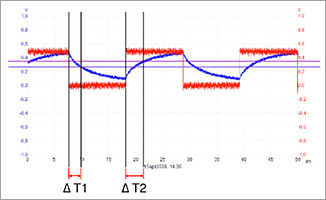

HOW THE L.I.F.E. BIOFEEDBACK SYSTEM WORKS
1. L.I.F.E. System – Technical Information (found on the L.I.F.E. System website)
The measurement made by the L.I.F.E. System is based upon the relationship between “action & reaction” by applying a challenge to the patient (“action”) and measuring the reaction of the human body as it answers the challenge (“reaction”). The basic principle of the mode of action of the L.I.F.E. System device is the following: The L.I.F.E. System device sends a square wave signal with amplitude of 5 Volt, and a duty cycle of 50% to the harness. The frequency to be applied, for determination of our test, is about 47.3 kHz. The measurement current through the body is limited to a maximum of 10mA, but usually no more than 5mA or less.
 Figure 1 shows the applied signal, without the harness being in contact with the
human body.
Figure 1 shows the applied signal, without the harness being in contact with the
human body.
Figure 1: Square wave signal with no harness in contact with the human Body. When the harness is in contact with the human body, a significant change (deformation) of the signal can be detected.
 Figure 2 shows the respective signals (but on a different time scale to underline
the changes)
Figure 2 shows the respective signals (but on a different time scale to underline
the changes)
Figure 2: Superimposition of the signal without harness being
applied to the human body (red signal) and with electrodes
being applied to the human body (blue signal).
As can be seen from the superimposition of the signals, there is a significant difference in the shapes of the signals. The detection of the signal is realized by the L.I.F.E. System device in a binary way – the part of the signal being placed in the upper half of the square wave signal is detected, the lower part of the square wave signal is ignored. Therefore, the different shapes of the signals (electrodes applied to a patient and no electrodes applied to the patient) result in time differences ΔT1 and ΔT2 before half of the amplitude is passed. These time differences resulting from the different shapes of the signals are detected by the L.I.F.E. System device.
When applying the same methodology to a patient suffering from a particular imbalance, again a signal will be detected. But as the situation in the body of the patient is different due to the imbalance, the shape of the signal to be detected is different, and it can be seen that this signal is less steep in the case of imbalance. This difference in signal shapes results in other time differences Δt1 and Δt2, which are characteristic for a particular imbalance.
 Figure 3 shows the signal obtained in the case of such an imbalance
Figure 3 shows the signal obtained in the case of such an imbalance
Figure 3: Superimposition of the Signal obtained from a patient suffering from a particular imbalance (blue signal) and the signal obtained when harness is not applied to the human body (red signal)
However, it must be pointed out that the results obtained by the L.I.F.E. System device can only give hints to physical states in which the presence of a particular imbalance is likely. The final diagnosis must be confirmed by other methodologies such as X-ray or MRI in any case. The basic principle of the L.I.F.E. System device is to measure these time differences of the respective signals and to achieve a statistical evaluation based on a mathematical algorithm. The results obtained are compared with data which are archived in a data base.
 Figure 4: Basic work flow for the evaluation of data obtained
Figure 4: Basic work flow for the evaluation of data obtained
The mathematical calculation algorithm takes input information on the one hand, which
is stored in the Element database, and on the other hand the digitized measurement
data, belonging to the element. After quantifying the values, artifacts (like disturbances
caused by EMC, movements, etc.) are removed. The cleaned data is sampled and after
that, the correlation is calculated, leading to the desired reactivity value, providing
the results of reactivity testing, relative to the given element.
It can be claimed
that when the situation inside the human body is disturbed due to a particular imbalance,
the physical situation will become different. Any abnormal condition can be considered
as a kind of imbalance, it can be easily seen that the temperature inside the area
of interest is different. As a consequence, the shape of the signal that is detected
will differ from the one measured in a non-conditional situation. The differences
can be measured easily by detecting the time difference, as described above, and
those time differences are characteristic for the respective situations. Evidence
that they can be measured and detected was given by the outcome of the clinical investigation.
2. Literature describing the effectiveness of the L.I.F.E. System device
Literature in peer reviewed journals describing the mode of action and effectiveness of the L.I.F.E. System was not available prior to the development of the L.I.F.E. System. Consequently, a clinical investigation giving evidence to the effectiveness was undertaken in 2006. The complete documentation and the results have already been submitted to and approved for European Class 2-A Certification. For more information please see the website for the L.I.F.E. Systems: http://www.life-het.com
WHAT IS BIOFEEDBACK ?
Bette Runck of the National Institute of Mental Health defines biofeedback as “a treatment technique in which people are trained to improve their health by using signals from their own bodies”. Modern medicine uses such devices as Electrocardiographs (ECG or EKG), Electroencephalograms (EEG), Blood Pressure Devices, and Thermometers. Each of these devices gives you feedback about your body, and that allows you to take corrective action. Traditional biofeedback devices measure heart rates, brain waves, electrical activity in muscles, skin resistance and body temperature for example. Feedback is in the form of a sound, a digital readout, a graph, or a stimuli and the client through practice or changes in behavior learns to modify certain bodily functions.

| Quantum Biofeedback |
| HRV Training |
| Stress Management |
| Body Balancer |
| Dental Biocompatibility |
| Virtual Session |
| Free Consult |
| FAQs |
| Individual Services Testimonials |
| Testimonials Adult Workshop |
| Testimonials Child Workshop |
| Virtual Sessions |